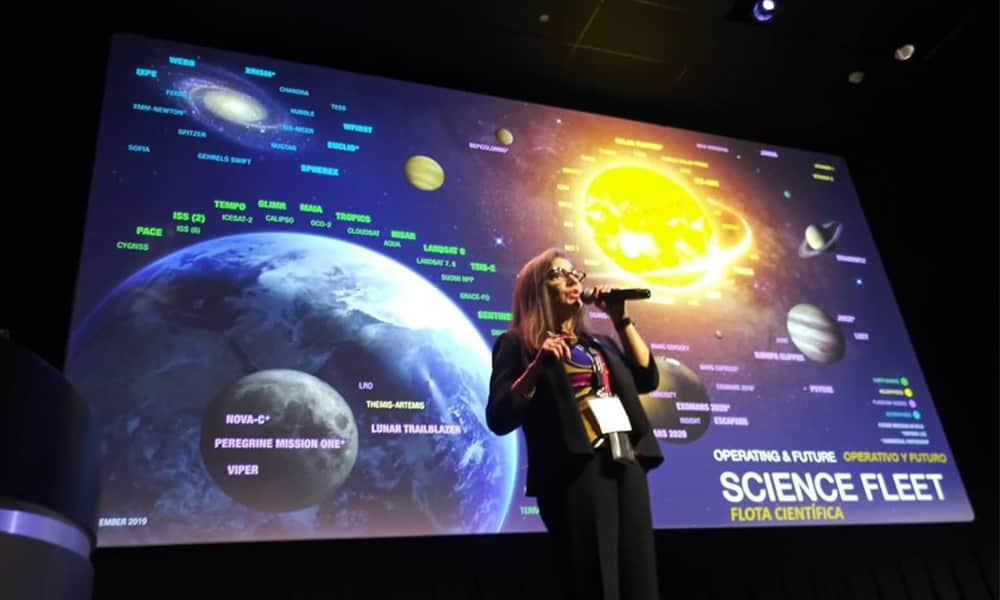How was your experience being the Marshall of the recent Festival de la Luz?
Being designated Marshall of the Festival de la Luz was a unique experience for me and for my mom. It was great to interact with the public and to be able to shake hands and take pictures with the youth.
I have to say that I was a bit concerned about COVID, but thankfully neither mom or I got sick. Mom enjoyed very much the attention and being wheeled through the Paseo Colon and Avenida Segunda.
I am personally very honored and grateful for the opportunity to be the Marshal of the Festival. My designation seems to have been very well received by the public.
I love Costa Rica and I am incredibly proud to represent Costa Rica in this fabulous institution, the National Aeronautics and Space Administration (NASA).
What have been some of the highlights of your job as Deputy Director of the Astrophysics Division?
As Deputy Director of the Astrophysics Division, I am responsible for providing executive leadership, strategic direction, and management for the entire agency’s multi-billion Astrophysics programs and missions necessary to discover how the universe works, to explore how the universe began and developed into its present form, and to search for Earth-like planets.
I have one of the few “Senior Executive Service (SES)” level positions the agency has. The Senior Executive Service (SES) is a position classification in the civil service of the United States federal government equivalent to general officer or flag officer rank in the U.S. Armed Forces.
NASA has approximately 18,000 employees (between civil servants and contractors) and only approximately 400 SES positions.
Members of the SES serve in the key positions just below the top Presidential appointees. SES members are the major link between these appointees and the rest of the Federal workforce and are the agency’s operational continuity when the administration changes.
Many people know something about NASA’s work. But most probably have no idea about how many different things the agency does. Astronauts in orbit conduct scientific research. Satellites help scientists learn more about Earth.
Space probes study the solar system, and beyond. New developments improve air travel and other aspects of flight. NASA is also beginning a new program to send humans to explore beyond the moon to Mars.
My responsibility is developing all of the missions such as Hubble, the James Webb Space Telescope (launched December 25, 2021), Fermi, Chandra, Swift, TESS and many other missions that are looking at our universe and how it functions.
Since I joined the Astrophysics Division, the highlight has been launching Webb. Webb is already having a unique and profound role in transforming our understanding of astrophysics and the origins of galaxies, stars, and planetary systems.
When Webb launched on Christmas Day of 2021, it was the culmination of decades of work by NASA scientists and engineers. The launch went off without a hitch, as did the numerous steps of the telescope’s deployment in the following months. In mid-July, Webb released its stunning first images.
What surprises do you think the James Webb Space Telescope might reveal, including about habitable exoplanets?
Webb is capable of collecting enough light from astronomical objects — ranging from birthing stars to exoplanets — to reveal what they are made of and how they are moving through space. This data has already begun to reveal the atmospheric composition of planets hundreds of light-years from Earth in great detail, offering hints as to their ability to potentially support life as we know it.
Scientists discovered the first exoplanets in the 1990s, and today there are over 5,000 known worlds orbiting faraway stars. Still, only around two dozen of these have been imaged directly.
Most exoplanets are so far away that they can only be detected through a dip in the light of the star they are orbiting, when that planet passes in front of its host star. But Webb could change that. In September 2022, it captured its first direct image of an exoplanet.
What are your upcoming plans at NASA and beyond?
I love my job and the people I work with and for the foreseeable future I will continue doing what I am doing.
How do you view the developments of the Costa Rican aerospace sector including the potential for a Costa Rica space agency?
There is a lot of potential for collaboration between NASA and the Costa Rican Space Agency, but first the Costa Rican Space Agency has to develop its strategic vision and secure steady funding. Without a strategic vision and steady funding the agency will not be seriously considered by other countries that have strong space programs.
Would NASA be willing to take up the conversation again with Costa Rica about the NASA I2 internship agreement? This would allow many young Costa Ricans to have an important avenue to develop their aerospace careers.
NASA was always willing. I personally tried many times since 2013. However, Costa Rica did not have an entity that could be responsible for executing the agreement and cover the costs of the internships. NASA can’t pay a foreign entity for its interns.
Maybe the Costa Rican Space Agency can be responsible for executing the I2 internship agreement with NASA. The I2 program was stopped during 2020 and 2021 due to COVID and NASA is recently restarting the program.






